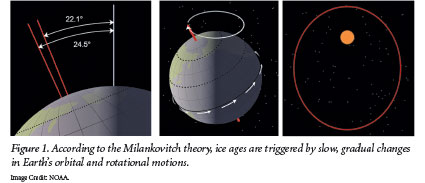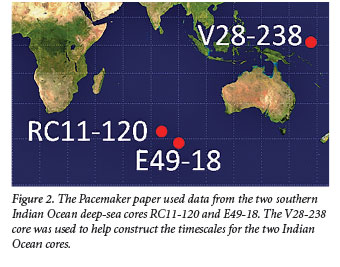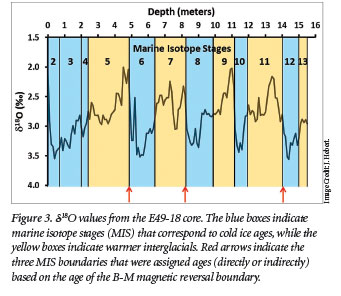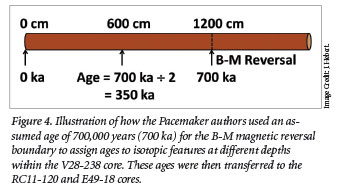Introduction
Next month marks the 40th anniversary of the publication of “Variations in the Earth’s Orbit: Pacemaker of the Ice Ages.”1 Regular Acts & Facts readers know that I’ve been analyzing this paper for quite some time.2 The Pacemaker paper is generally thought to have confirmed the secular explanation for the many recent Pleistocene ice ages that supposedly occurred during Earth’s prehistoric past. This paper’s importance is routinely acknowledged in textbooks, and it is no exaggeration to say that the paper is an icon of uniformitarian and old-Earth thinking.
After much hard work, I am ready to share my conclusions with you. The results of this iconic Pacemaker paper are—even by uniformitarian reckoning—largely invalid. Moreover, they have been invalid for nearly a quarter century!
Incredibly, most secular scientists seem to be completely unaware of this fact. In this and next month’s Impact articles, I will explain how uniformitarian scientists inadvertently undermined the conclusions of this paper.
Alternate Ice Age Explanations
Uniformitarian scientists, who reject the Bible’s testimony of recent creation and the global Flood, claim there have been about 50 ice ages in the last 2.6 million years.3 However, creation scientists argue that Earth has experienced just a single Ice Age—a consequence of the never-to-be-repeated Genesis Flood (Genesis 6–8). Former meteorologist for the National Weather Service and creation scientist Michael Oard has proposed a detailed and convincing Ice Age explanation that solves a number of well-known mysteries, such as how millions of wooly mammoths were able to thrive in Siberia during the Ice Age and why afterward they suddenly became extinct.4,5
There is strong geological evidence for a single Ice Age but not for the dozens of ice ages claimed by uniformitarians. The main reason secular scientists believe in multiple ice ages is that they interpret chemical wiggles within cores extracted from deep-seafloor sediments to represent many ice age cycles.3
The Milankovitch Ice Age Theory
Uniformitarians claim ice ages are triggered by changes in the way sunlight falling on the earth is distributed with latitude and season. Supposedly, the high-latitude northern ice sheets grow at times when there is less summer sunlight falling on them. This results in glacial intervals, or (in popular speech) ice ages. Likewise, when there is more summer sunlight falling on these northern high-latitude ice sheets, the sheets shrink, and a warmer period called an interglacial results. This is called the Milankovitch, or astronomical, ice age theory.
 These changes in sunlight distribution are thought to be caused by slow changes in Earth’s orbital and rotational motions over many tens of thousands of years (Figure 1). Because uniformitarian scientists believe the solar system is billions of years old, they feel free to extrapolate these motions backward into the supposed prehistoric past. According to these extrapolated calculations, Earth’s orbital motions should exhibit dominant cycles of roughly 100,000, 41,000, and 23,000 years. Because they can calculate the past times when this high-latitude summer sunlight would presumably have been weaker, they believe they can also calculate the approximate times these supposed ice ages occurred.
These changes in sunlight distribution are thought to be caused by slow changes in Earth’s orbital and rotational motions over many tens of thousands of years (Figure 1). Because uniformitarian scientists believe the solar system is billions of years old, they feel free to extrapolate these motions backward into the supposed prehistoric past. According to these extrapolated calculations, Earth’s orbital motions should exhibit dominant cycles of roughly 100,000, 41,000, and 23,000 years. Because they can calculate the past times when this high-latitude summer sunlight would presumably have been weaker, they believe they can also calculate the approximate times these supposed ice ages occurred.
 Although there are many theoretical problems with the Milankovitch theory, it is generally thought to have been vindicated by the Pacemaker paper.6 The authors analyzed chemical wiggles in two sediment cores from the Indian Ocean designated as RC11-120 and E49-18. Because the Pacemaker analysis showed evidence of climate cycles having lengths of 42,000, 23,000, and about 100,000 years, it was seen as confirming the Milankovitch ice age theory. A third core from the western Pacific Ocean, designated as V28-238, also played a critical role in the analysis (Figure 2).
Although there are many theoretical problems with the Milankovitch theory, it is generally thought to have been vindicated by the Pacemaker paper.6 The authors analyzed chemical wiggles in two sediment cores from the Indian Ocean designated as RC11-120 and E49-18. Because the Pacemaker analysis showed evidence of climate cycles having lengths of 42,000, 23,000, and about 100,000 years, it was seen as confirming the Milankovitch ice age theory. A third core from the western Pacific Ocean, designated as V28-238, also played a critical role in the analysis (Figure 2).
Pacemaker Problems
There are significant problems with the Pacemaker paper. First, the authors excluded nearly one-third of all the data from the longer E49-18 core, an omission that other secular scientists have since claimed may have been needless.1,7 Second, before the authors could perform their calculations, they had to construct timescales for the cores. The most recent magnetic reversal, in which Earth’s magnetic poles flipped, is named the Brunhes-Matuyama (B-M) magnetic reversal, and it played an important role in the Pacemaker paper.
Creation scientists argue that these magnetic reversals occurred quickly and were initiated by the Genesis Flood, but uniformitarian scientists claim they occurred slowly over long ages.8 In the early 1970s, uniformitarian scientists assigned an age of 700,000 years (700 ka) to the B-M reversal boundary, and this age was used to construct the timescales for the two Indian Ocean cores, especially the longer E49-18 core.1,9
In order to understand why the Pacemaker paper is no longer valid, it is necessary to cover some additional background material.
Seafloor Sediments and Oxygen Isotope Ratios
There are several different varieties, or isotopes, of the oxygen atom. One of these varieties, oxgyen-18 (18O), is slightly heavier than the oxygen-16 (16O) variety. Scientists measure the ratio of oxgyen-18 atoms to oxgyen-16 atoms in a sample and calculate a quantity called the oxygen isotope ratio, denoted by the symbol δ18O.
Tiny marine creatures called foraminifera build their shells out of calcium carbonate (CaCO3), a molecule that contains oxygen. These creatures use both 18O and 16O to construct their shells. When these foraminifera die, their shells become part of the accumulated debris on the ocean floor.
 Researchers can calculate δ18O values from foraminifera remains buried at different depths within the seafloor sediments. When these values are plotted as a function of depth on a graph, numerous wiggles can be seen. The oxygen isotope ratios from the E49-18 core are shown in Figure 3.
Researchers can calculate δ18O values from foraminifera remains buried at different depths within the seafloor sediments. When these values are plotted as a function of depth on a graph, numerous wiggles can be seen. The oxygen isotope ratios from the E49-18 core are shown in Figure 3.
Uniformitarian scientists believe these δ18O values are global climate indicators. Within seafloor sediments, higher oxygen isotope values are thought to indicate times when the ice sheets were larger (i.e., colder ice ages), and lower oxygen isotope values are thought to indicate times when the ice sheets were smaller (warmer interglacials).
Marine Isotope Stages
Because uniformitarian scientists believe that the δ18O signal is a global climate indicator, they think the same pattern of δ18O wiggles that appears in one sediment core should also appear in another sediment core, even when the cores are separated by thousands of miles. They recognize this will not always be the case, as seafloor sediments may be disturbed and local “noise” can distort the climate signal. However, they believe that, in principle, prominent δ18O features, such as pronounced peaks or troughs, in one sediment core should have the same age as the corresponding δ18O features in a second sediment core. This means they can, in theory, transfer the ages assigned to δ18O wiggles in one core to the corresponding δ18O wiggles in a second core.
Uniformitarians have devised a numbering system involving marine isotope stages (MIS) to help keep track of prominent features within the δ18O signal. The 12 different marine isotope stages identified in the E49-18 core are the blue and yellow rectangles in Figure 3. Generally, the boundaries of the marine isotope stages, indicated by the vertical lines, are thought to represent times at which Earth was transitioning from an ice age to an interglacial, or vice versa.
Assigning Ages to the Cores
Before they could perform their analysis, the Pacemaker authors had to assign ages to the sediments within the two Indian Ocean cores. This wasn’t easy, as radioisotope dating methods can’t generally be used on seafloor sediments. Therefore, they needed a way to indirectly date those sediments, and this is where the B-M magnetic reversal boundary played a critical role.
Magnetic reversals are recorded in volcanic rocks, and uniformitarians use radioisotopic dating methods to assign ages to those rocks. By the mid-1970s, uniformitarian scientists had already used radioisotope dating to assign an age of 700,000 years (700 ka) to volcanic rocks showing the B-M magnetic reversal. Moreover, because seafloor sediments contain magnetic minerals, a reversal of Earth’s magnetic field may also be “recorded” within long sediment cores. The B-M magnetic reversal boundary was identified at a depth of 1,200 cm (about 40 feet) within the V28-238 sediment core.
Uniformitarian scientists believed the sediments within the V28-238 core were deposited at a nearly constant rate for hundreds of thousands of years. They assumed the very top of the sediment core had an age of zero, since the uppermost sediments were deposited very recently—presumably yesterday. Likewise, since they believed the reversal occurred 700,000 years ago, the age of the sediments at a depth of 1,200 cm within the V28-238 core should have been 700,000 years.
 Then researchers used depth down the core to assign ages to oxygen isotope features at various locations within the V28-238 core. For instance, the sediments halfway between the core top and 1,200 cm would presumably have an age that was itself halfway between 0 years and 700,000 years—that is, 350,000 years (Figure 4). They used this method to assign ages to 21 marine isotope stage boundaries within the V28-238 core and then used, either directly or indirectly, three of those ages in the Pacemaker analysis.
Then researchers used depth down the core to assign ages to oxygen isotope features at various locations within the V28-238 core. For instance, the sediments halfway between the core top and 1,200 cm would presumably have an age that was itself halfway between 0 years and 700,000 years—that is, 350,000 years (Figure 4). They used this method to assign ages to 21 marine isotope stage boundaries within the V28-238 core and then used, either directly or indirectly, three of those ages in the Pacemaker analysis.
A New Age for the B-M Reversal
However, in the early 1990s, uniformitarian scientists revised the age of the B-M reversal to 780,000 years.10 This means that, by their own reckoning, the ages they originally assigned to the marine isotope stage boundaries are no longer valid. Incredibly, it seems that uniformitarian scientists never bothered to check whether this revision would adversely affect the Pacemaker results. When one re-performs the Pacemaker analysis using the revised age for the B-M reversal boundary, one obtains a bombshell result: the analysis no longer provides convincing support for the Milankovitch theory!
We will continue this discussion next month, but for readers who don’t want to wait that long, my results have been published online in three technical papers.11,12,13
Click here to read “Milankovitch Meltdown: Toppling an Iconic Old-Earth Argument, Part 2.”
References
- Hays, J. D., J. Imbrie, and N. J. Shackleton. 1976. Variations in the Earth’s Orbit: Pacemaker of the Ice Ages. Science. 194 (4270): 1121-1132.
- Hebert, J. 2016. Seafloor Sediment Research: Nearing Completion. Acts & Facts 45 (7): 9.
- Walker, M. and J. Lowe. 2007. Quaternary science 2007: a 50-year retrospective. Journal of the Geological Society, London. 164 (6): 1073-1092.
- Oard, M. J. 1990. An Ice Age Caused by the Genesis Flood. El Cajon, CA: Institute for Creation Research.
- Hebert, J. 2014. Wooly Mammoth Mystery Finally Solved? Creation Science Update. Posted on ICR.org February 28, 2014, accessed August 23, 2016.
- Oard, M. J. 2007. Astronomical troubles for the astronomical hypothesis of ice ages. Journal of Creation. 21(3): 19-23.
- Howard, W. R. and W. L. Prell. 1992. Late Quaternary Surface Circulation of the Southern Indian Ocean and Its Relationship to Orbital Variations. Paleoceanography. 7 (1): 79-117.
- Humphreys, D. R. 1990. Physical Mechanism for Reversals of the Earth’s Magnetic Field During the Flood. In Proceedings of the Second International Conference on Creationism, vol. 2. R. E. Walsh and C. L. Brooks eds. Pittsburgh, PA: Creation Science Fellowship, 129-142.
- Shackleton, N. J. and N. D. Opdyke. 1973. Oxygen Isotope and Palaeomagnetic Stratigraphy of Equatorial Pacific Core V28-238: Oxygen Isotope Temperatures and Ice Volumes on a 105 Year and 106 Year Scale. Quaternary Research. 3 (1): 39-55.
- Shackleton, N. J., A. Berger, and W. R. Peltier. 1990. An alternative astronomical calibration of the lower Pleistocene timescale based on ODP Site 677. Transactions of the Royal Society of Edinburgh: Earth Sciences. 81 (4): 251-261.
- Hebert, J. 2016. Should the “Pacemaker of the Ice Ages” Paper Be Retracted? Part 1. Answers Research Journal. 9: 25-56.
- Hebert, J. 2016. Should the “Pacemaker of the Ice Ages” Paper Be Retracted? Part 2. Answers Research Journal. 9: 131-147.
- Hebert, J. 2016. Should the “Pacemaker of the Ice Ages” Paper Be Retracted? Part 3. Answers Research Journal. 9: 229-255.
* Dr. Hebert is Research Associate at the Institute for Creation Research and earned his Ph.D. in physics from the University of Texas at Dallas.














